

Explore the history, culture, people and beautiful landscapes of Vietnam on the 63Stravel travel app
Download the 63stravel app

Currently, Cu Chi Tunnels are carrying out procedures to submit to UNESCO for recognition as a World Heritage Site. This is also a tourist destination visited by a large number of foreign tourists when coming to Ho Chi Minh City.
Located about 70km northwest of Ho Chi Minh City center, Cu Chi Tunnels (Phu My Hung commune, Cu Chi district) is one of the places chosen by many foreign tourists when coming here.
Accordingly, just by searching with the keyword "Cu Chi tunnels" on social networking platforms, viewers can see a series of videos recorded by Western visitors with content about the historical destination of this land of steel. accompanied by status lines expressing excitement and amazement at the experience of "going underground".
Even many experience videos of international tourists here attract "huge" views, up to several tens of millions of views and millions of interactions.
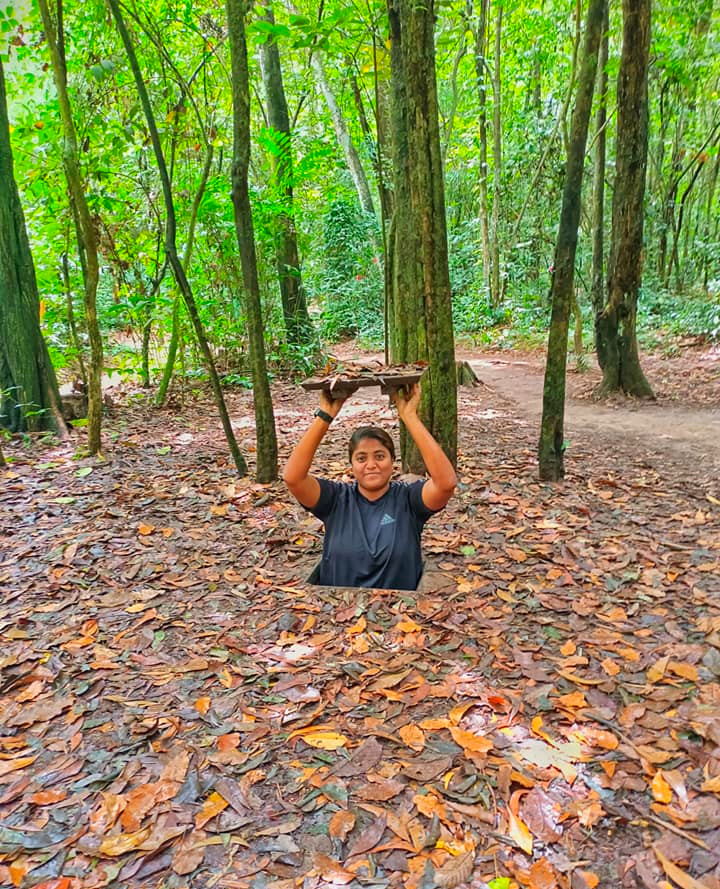
Western tourists enjoy the experience of "going underground" in Cu Chi tunnels (Source: Hoa Di Linh)
Among them is a video by Joe Hattab (a tourist from Spain) with a length of less than 1 minute but attracting more than 40 million views and more than 2.2 million likes, becoming one of the videos of Western visitors in Vietnam. Cu Chi tunnels are the "hottest" ever.
However, Joe Hattab is not the only foreign tourist who feels surprised and excited when visiting the Cu Chi tunnels. According to the reporter's research, on some international travel applications, tours to experience the Cu Chi tunnels are posted and sold. Therefore, there are many Western tourists who know about it and want to come here and experience it once.
Representatives of some travel agencies in Ho Chi Minh City said that tour products to this destination are always of interest and choice to international tourists when traveling to Ho Chi Minh City.
The tour schedule to Cu Chi Tunnels usually lasts half a day, departing at 7:30 a.m. or 1 p.m. with a price of about 400,000 - 500,000 VND/person, accompanied by an English tour guide.
Most Western tourists prefer this tour product because it is convenient in terms of time and transportation as well as the opportunity to learn more deeply about Vietnamese history.
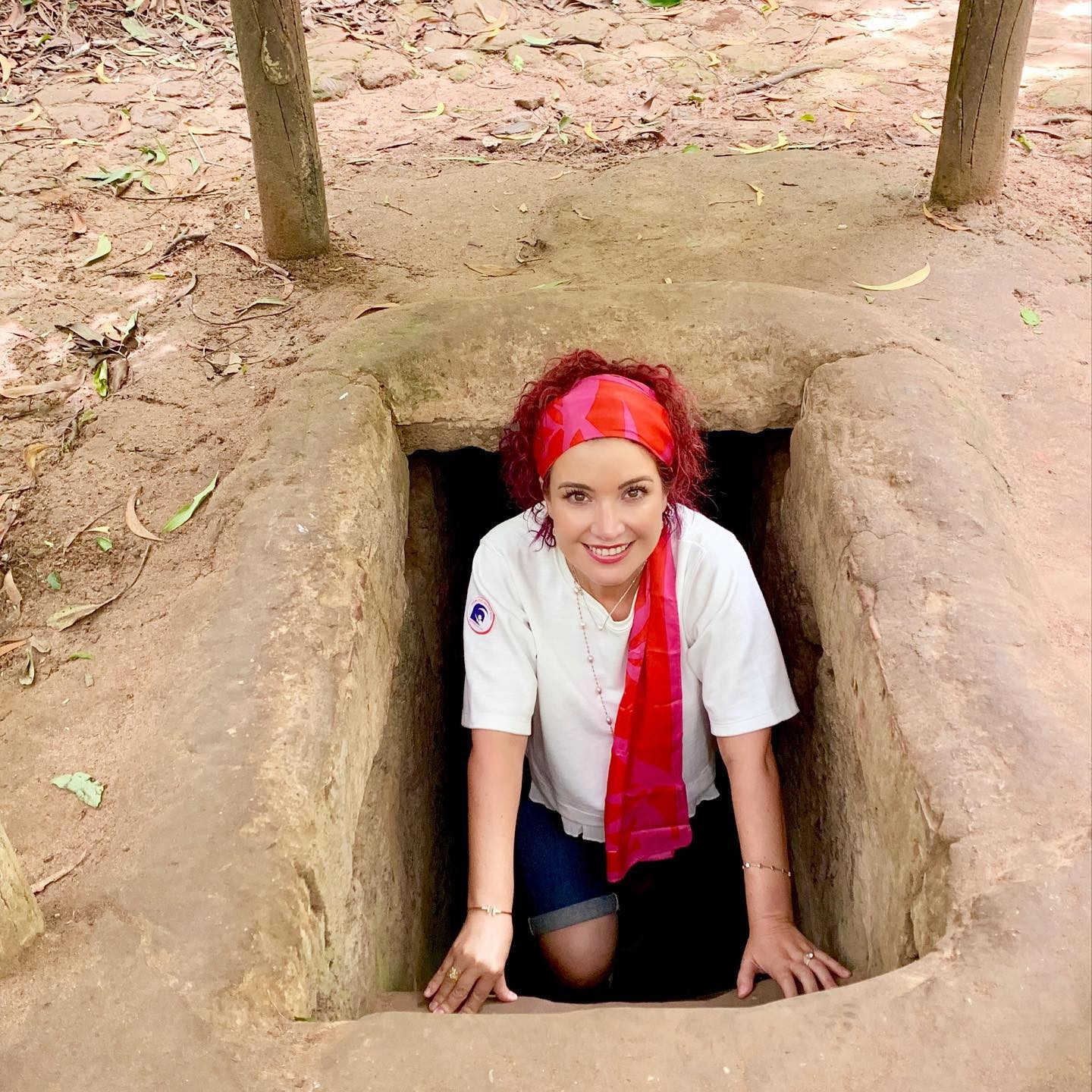

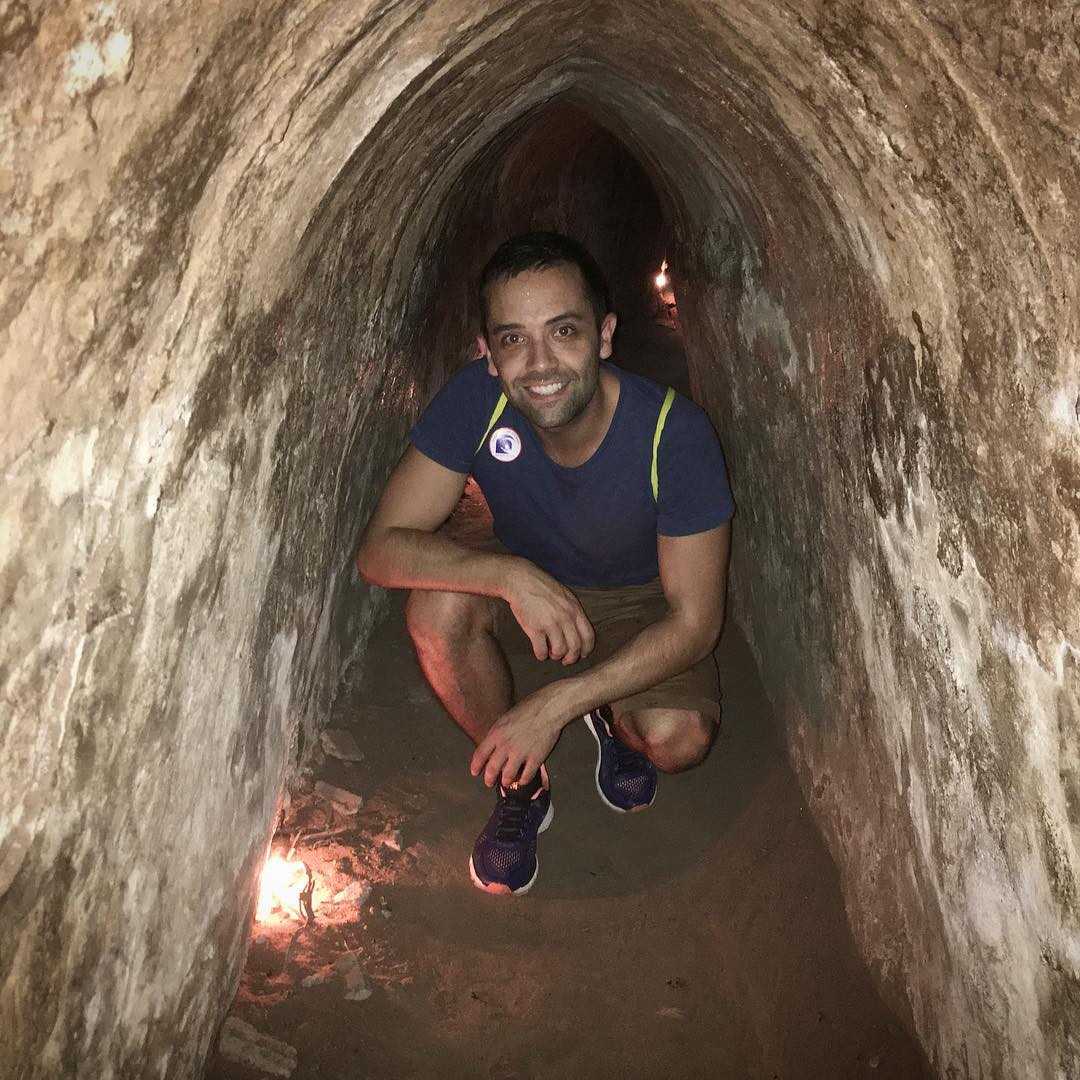
At Cu Chi Tunnels, most visitors feel curious and excited when being guided into the secret tunnel and especially trying to "crawl underground" through the tiny brick path (Photo: @lizzethmarcos, @markytagala, @thewelltravelled)
Vincent Reed, a tourist from Ireland, commented that Cu Chi Tunnels is not only a place for those who want to learn about the heroic history of the local army and people during the anti-American period, but also a place to relax. Ideal for everyone because of the green, fresh and peaceful scenery.
“My foreign friends have been to Cu Chi tunnels and have a very good impression of this place. They inspire me, urging me to come here once. After listening to the tour guide's presentation, I was truly impressed and moved by the brave and cunning fighting spirit of the Vietnamese people.
At the tunnels, I tried shooting guns, crawled into tiny tunnels and ate delicious cassava (cassava). I hope this destination will become more known, so that generations of Vietnamese and foreign tourists will have the opportunity to visit and experience," the Irish guest shared.
In addition to experiencing the tunnels, tourists coming here will also be introduced to Hoang Cam kitchen and enjoy boiled cassava (tapioca) dipped in sesame salt - a familiar dish of the soldiers and people of Cu Chi land during difficult times. Tourists are also excited to participate in games such as disassembling guns, fighting fake battles with paintball guns, shooting national defense sports, etc.
This is also an ideal picnic spot for tourists because of its fresh space, separate from the city and many unique activities such as cycling, swimming, camping, eating, boating, and canoeing. , ride ducks or explore local cuisine,...
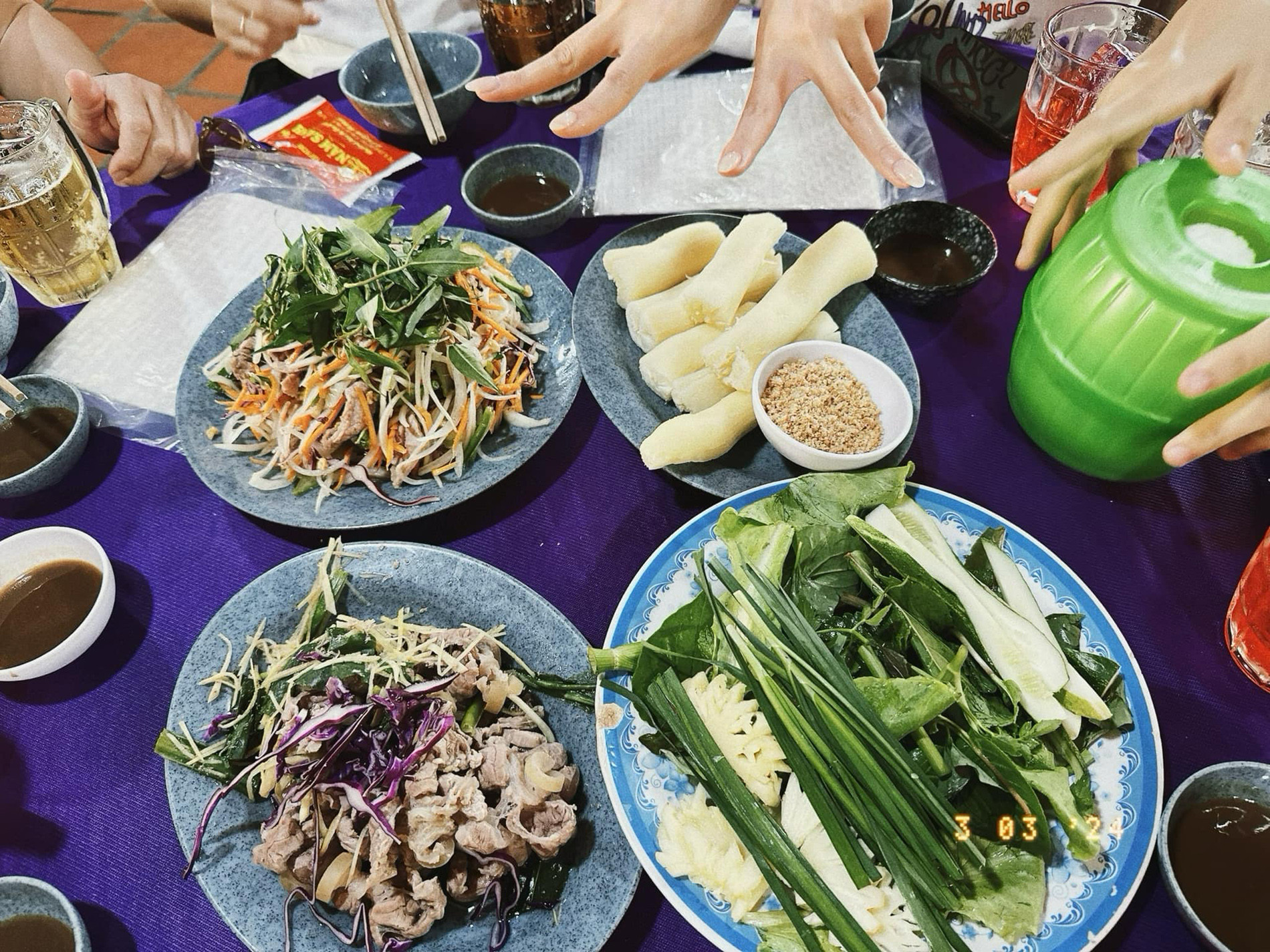
Tourists enjoy the familiar cassava (cassava) dish in Cu Chi tunnels (Photo: Nguyen Minh Trang)
Representatives of many travel agencies commented that Cu Chi Tunnels is not only a historical tourist attraction but also a very unique intangible cultural work of Vietnam, worthy of becoming a world heritage.
In order to promote the values and meanings that this destination brings as well as the desire to become more known to international tourists, recently, the Department of Culture and Sports of Ho Chi Minh City has just submitted a report to the People's Committee. The city completed the summary report of Cu Chi Tunnels and explained some contents to the Ministry of Culture, Sports and Tourism about submitting to UNESCO to include this tunnel in the proposed list of world heritage sites. .
Cu Chi Tunnels is a resistance base, with a solid defense system deep underground with a tunnel system up to 200 km long, 3-12m deep, including 12 floors, built in a sophisticated way. complex, mysterious, fully functional to live and fight as well as withstand the destructive power of modern warfare means at that time.
Cu Chi Tunnels was once ranked in the Top 25 iconic Asian destinations voted by TripAdvisor users - a prestigious and popular global travel application (in 2017); Among the top 7 world-famous tunnel tours (2018) voted by Hong Kong's South China Morning Post newspaper and once listed by CNN as one of the world's top underground destinations.
Currently, the Cu Chi Tunnels are being carried out by the cultural sector to submit procedures to submit to UNESCO for recognition as a World Heritage Site.
Coming to Ho Chi Minh, the famous city, visitors can also visit many other tourist attractions such as:
1. Dam Sen Water Park
Coming to Dam Sen Water Park, you will immediately feel a green oasis located right in the heart of the city. With 36 modern water game equipment and a cool 3,000m2 wave pool, it promises to bring you many exciting feelings of relaxation. Modern 3000m2 water park with modern wave technology and 31 challenging games. See details
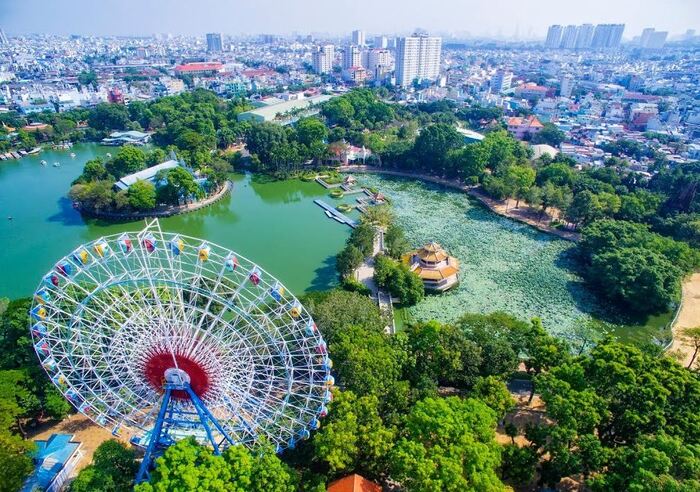
2.Ho Chi Minh City Theater
Ho Chi Minh City Opera House is one of the typical architectural and cultural works of the city today. The front of the theater faces Lam Son Square and Dong Khoi Street. See details
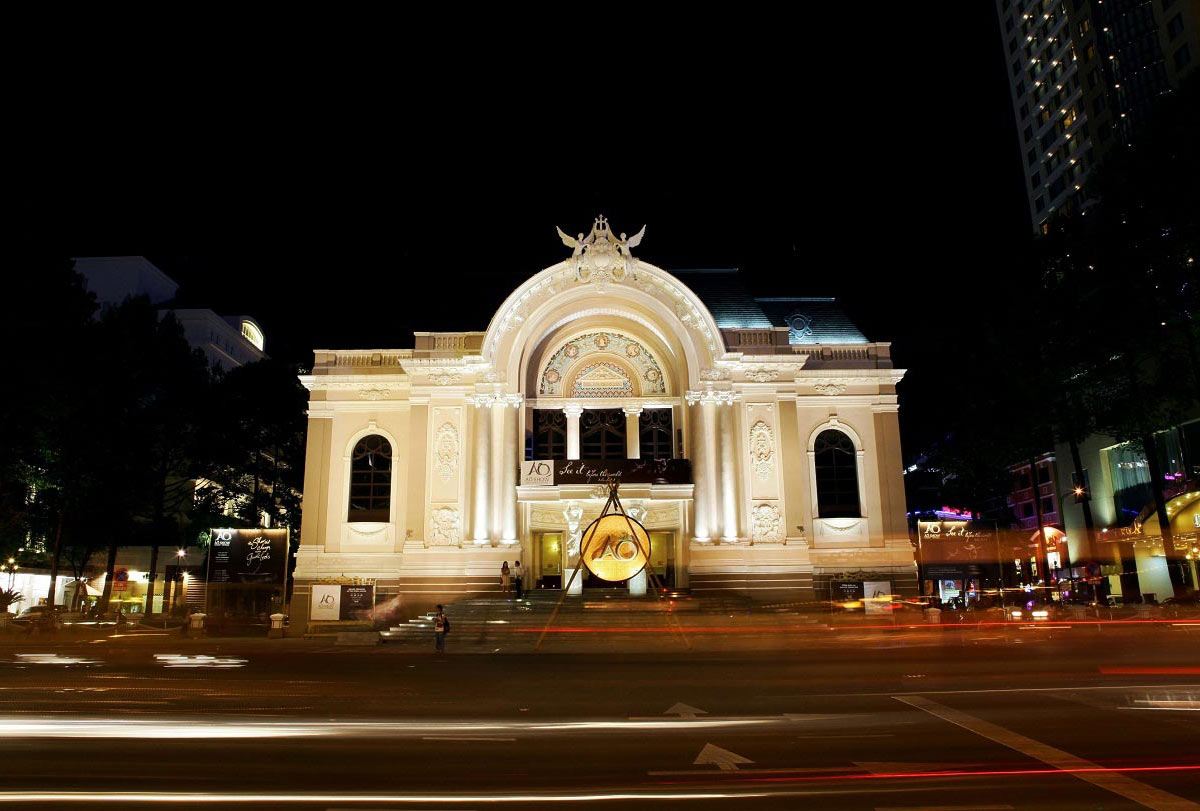
3.Ben Thanh Market
Ben Thanh market is located in the center of District 1, the most crowded and magnificent area in Saigon. Located near many famous Saigon tourist attractions such as the Independence Palace, City Post Office, City Theater... and many high-end 5-star hotels, Ben Thanh market attracts many tourists. Ben Thanh Market was formed in the mid-19th century. See details
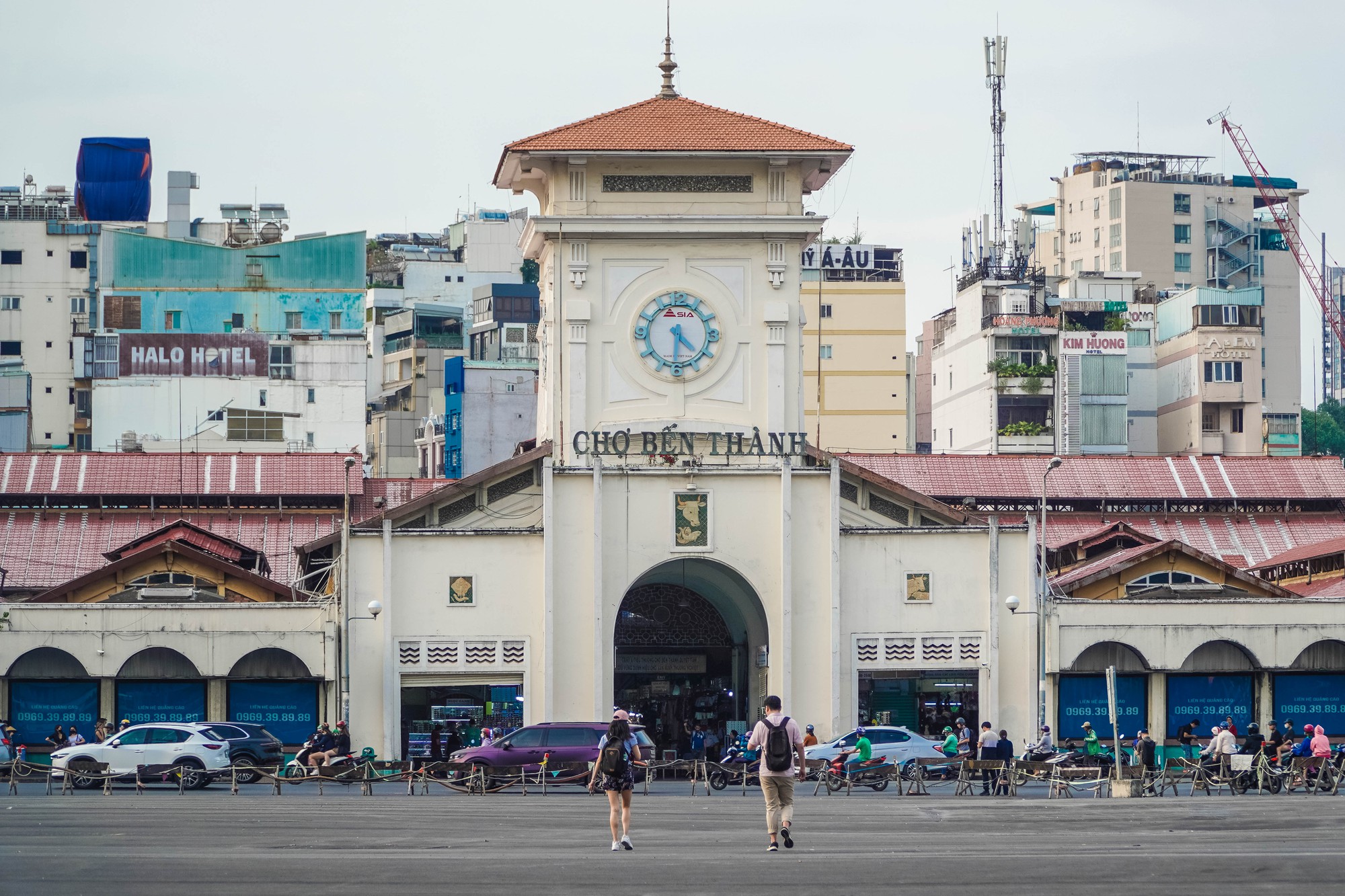
4. Notre Dame Cathedral
Notre Dame Cathedral or Saigon Notre Dame Cathedral is a name that people shorten for convenient use. The full name of this project is the Cathedral Basilica of the Immaculate Conception. The church is 91m long, 35.5m wide, and the main dome is 21m high. The two bell towers on both sides are nearly 57m high. See details
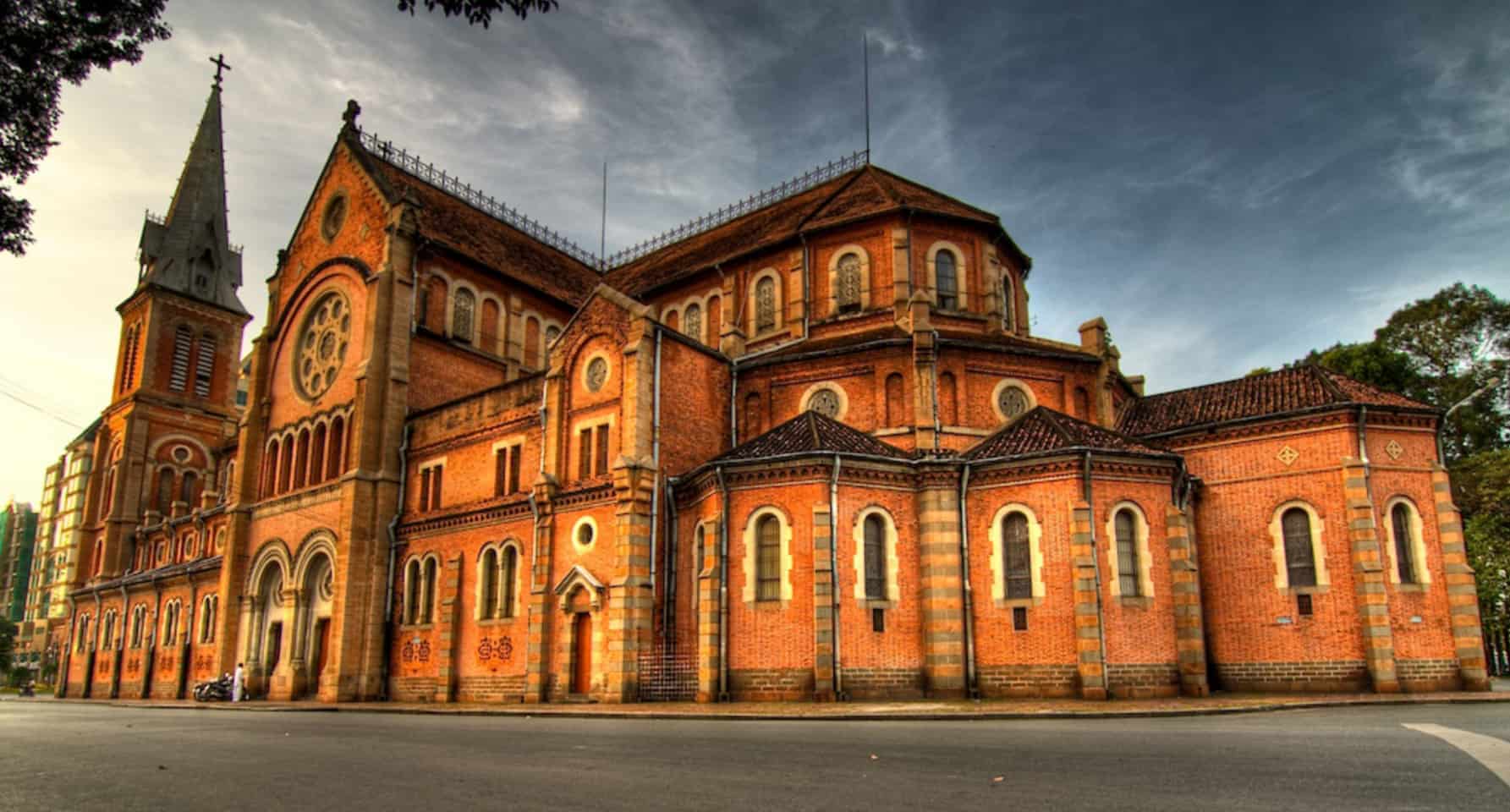
5. Starlight Bridge
Starlight Bridge is one of the impressive attractions in District 7, Ho Chi Minh City. This destination is located in one of the most luxurious neighborhoods in Saigon. See details
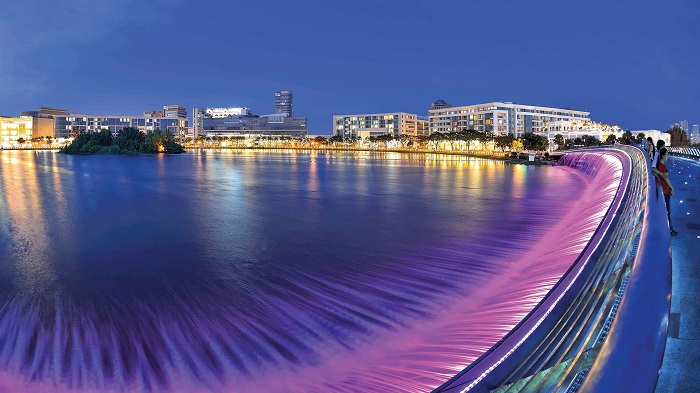
Ho Chi Minh City 1945 view
Update day : 21/03/2024
On scorching hot days, everyone wants to immerse themselves in the cool, clear blue water. Coming to Dam Sen water park, you can dispel all the fatigue in life. Dam Sen water park with unbelievable ticket prices will be an ideal tourist destination for all tourists in the days when Saigon "lacks" storms. rain. The harmonious space combined with romantic rivers melts away worries and sadness and also provides energy for a new day. Coming to Dam Sen Water Park, you will immediately feel a green oasis located right in the heart of the city. With 36 modern water game equipment and a cool 3,000m2 wave pool, it promises to bring you many exciting feelings of relaxation. Modern 3000m2 water park with modern wave technology and 31 challenging games. Visitors will experience a cool space like being in a green oasis located in the heart of Saigon. Immerse yourself in healthy yet romantic waves to dispel the fatigue and burdens of life. Recharge your energy for a new working week. When coming to Dam Sen Water Park, you will experience the following games: Children's Pool, Wave Pool, Buoyant Slide 3 - Boomerang, Water Jet Massage, Super Speed - Kamizake, Tornado - Tornado,.. and many other games.
Ho Chi Minh City 2234 view
From January to December
Ho Chi Minh Opera House is located at 7 Cong Truong Lam Son Street, Ben Nghe Ward, District 1. It is one of the oldest buildings in Ho Chi Minh City following the flowery Western European architecture. Ho Chi Minh City Opera House is one of the typical architectural and cultural works of the city today. The front of the theater faces Lam Son Square and Dong Khoi Street. Next door are two large hotels, Caravelle and Continental. With a convenient location in the city center, the theater is not only a place to organize events but also an interesting tourist destination that attracts many tourists to visit and admire. Saigon Opera House is also an architectural counterpart to Hanoi Opera House. The authors of this ancient architectural building are architects Ernest Guichard, Eugène Ferret and Félix Olivier. Built in 1900 in the "flamboyant" architectural style of the Third French Republic. The facade of the opera house is clearly influenced by the art of the Petit Palais Museum that appeared in the same year in France. The inside is modernly designed with full equipment for sound and lighting. In addition to the ground floor, there are 2 additional floors with a capacity of up to 1800 seats. All decorative patterns, facade reliefs and interiors of the theater were painted by a famous artist in France to resemble the patterns of theaters in France at the end of the 19th century, extremely beautiful. The system of arched doorways with raised railings is designed with bold classical French architecture. Having gone through many historical events, up to now, the Ho Chi Minh City Opera House has been somewhat damaged. Until 1955, the theater was renovated but was used as the House of Representatives of the Republic of Vietnam government. And after 1975, the theater returned to its original function of organizing performing arts. On the occasion of 300 years of Saigon - Gia Dinh, in 1998, the Ho Chi Minh City government decided to renovate the opera house with the motto of preserving the original architectural style. Therefore, the embossed decorations and sculptures on the facade such as the statue of the goddess of art, the flower strings... have all been restored to their original state compared to nearly 100 years ago. Regardless of whether you are interested in learning about culture or simply admiring beautiful architectural works. Ho Chi Minh City Opera House will be your indispensable stop during your trip around Saigon. A beautiful architectural work that has contributed to adding elegance and charm to Ho Chi Minh City. In addition to visiting and admiring the ancient architecture of the Opera House, visitors can visit the Continental Saigon Hotel. One of the oldest hotels in Saigon, hundreds of years old. This place has welcomed many heads of state and politicians from all over the world.
Ho Chi Minh City 2046 view
From January to December
When mentioning Saigon, people often think of the most modern and bustling city in the country, but few people remember that Saigon also has many historical marks of its own. Cu Chi Tunnels are a clear proof of that. Only by going to the Cu Chi Tunnels can we partly understand the magnanimity of Vietnamese history. Cu Chi Tunnels is located about 70 km from Saigon center. This is the place where the transformation of Cu Chi's army and people during the 30-year resistance war to bring independence and freedom to the country is captured. The tourist area consists of 2 parts, 13km apart: Ben Duoc tunnels are located in Phu Hiep hamlet, Phu My Hung commune, Cu Chi district and Ben Binh tunnels are in Nhuan Duc commune and the main tunnel area. Cu Chi Tunnels have a length of up to about 250 km, from the "backbone" of the tunnel it spreads out like a spider web in the ground, including works: tunnels, trenches, embankments, fighting nests, food bunkers. , sleeping, meeting, kitchen, well, storage... The works are connected to each other or can be independent depending on the terrain. Some branches of the tunnel flow into the Saigon River so that in case of emergency, you can cross the river through Ben Cat base (Binh Duong). Inside the Cu Chi tunnels, it is dark and lacking in atmosphere. There are many places where visitors have to stoop to walk. Depending on the terrain, the tunnel can have up to 2 or 3 floors. The closest floor of the tunnel, about 3 meters from the surface, can withstand the weight of tanks and armored vehicles; some deeper places can withstand small bombs. Some hatches are designed into very flexible combat nests and sniper gun emplacements. Around the tunnel door, there are also many spike tunnels and mine pits. Thanks to its intricate and flexible architecture, this place sheltered many officials and people of Saigon during the resistance war against the enemy. Even though the enemy used many methods to destroy the tunnels such as: using water to break through, using an army of "rats", using sniffer dogs, etc. But all failed. In addition to the special historical relics of Cu Chi Tunnels, there are many other interesting fun activities here such as: national defense sports shooting, paintball shooting, swimming, boating on the lake or renting bicycles around. Tunnels. Going around the Cu Chi tunnels tourist area is also an experience worth trying. Here the air is fresh, not noisy like the inner city of Saigon, giving anyone who comes here a feeling of relaxation.
Ho Chi Minh City 1979 view
From January to December
Ben Thanh market is located in the center of District 1, the most crowded and magnificent area in Saigon. Located near many famous Saigon tourist attractions such as the Independence Palace, City Post Office, City Theater... and many high-end 5-star hotels, Ben Thanh market attracts many tourists. Ben Thanh Market was formed in the mid-19th century. Through the ups and downs of history, this market has long become a symbol of the vibrant trading culture of Saigon in particular and Vietnam in general. Along with the economic and tourism development of Ho Chi Minh City, this market is also increasingly famous and especially attracts a large number of foreign tourists to visit. Vietnamese people are no strangers to crowded, bustling markets. But for foreigners, this is a very unique cultural feature. Therefore, foreign tourists love to go to the market to shop for souvenirs and try Vietnamese specialties. Gradually, Ben Thanh became a prominent symbol of Saigon, making everyone who comes to this city want to visit once. Ben Thanh Market was originally built in the 17th century near the Ben Nghe River to welcome tourists and soldiers into Gia Dinh Citadel. That is also the reason why the market was named Ben Thanh (river wharf + citadel). The market is made of brick, wood and thatched roof. Ben Thanh market in the past was very crowded and bustling, with boats and boats busy day and night. After a long period of use, the market gradually deteriorates and is at risk of collapsing at any time. Therefore, the French rebuilt it and expanded it to a larger scale after filling in a muddy pond named Bo Ret. Since 1912, it took another 2 years for the French construction contractor Brossard et Maupin to complete this project. The old architecture has since been preserved to this day even though Ben Thanh market underwent a major renovation and repair in 1985. Ben Thanh Market has 4 main gates and 12 side gates. Each main gate is located on a different street and displays many popular items for visitors to shop: South gate of Ben Thanh market: South gate is located on Le Loi street, opposite Quach Thi Trang park, this is the main gate of the market. The highlight of this market gate is the famous 3-sided clock tower. The entrance attracts many visitors with stalls selling all kinds of goods, mainly fabrics and dry foods. East Gate of Ben Thanh Market: East Gate is located on Phan Boi Chau Street, a paradise for cosmetics enthusiasts. The stalls here sell a variety of body, skin and hair care products. West gate of Ben Thanh market: West gate is located on Phan Chu Trinh street, this gate has many stalls selling shoes, crafts and souvenirs. North gate of Ben Thanh market: North gate is located on Le Thanh Tong street, this gate sells many types of fresh flowers and tropical fruits. During the day, Ben Thanh market bustles with stalls offering a variety of goods, including textiles, souvenirs, handicrafts, fresh produce, seafood, spices... Atmosphere This place has the true nature of a typical Asian market, bustling and rustic. Ben Thanh Market at night is still crowded but somewhat more peaceful. The stalls mainly sell food with local snacks and drinks. There are also some shops selling clothes, accessories and souvenirs. Bright torches and the sweet aroma of countless Vietnamese specialties are what attract tourists.
Ho Chi Minh City 2349 view
From January to December
Notre Dame Cathedral or Saigon Notre Dame Cathedral is a name that people shorten for convenient use. The full name of this project is the Cathedral Basilica of the Immaculate Conception. The church is 91m long, 35.5m wide, and the main dome is 21m high. The two bell towers on both sides are nearly 57m high. Saigon Notre Dame Cathedral was built with classic French architecture, designed by talented architect J.Bourard. The outside space of the church is very large and airy, the inside is majestic and ancient. The history of Saigon Notre Dame Cathedral began with the French war of invasion at the end of the 19th century. The French government at that time wanted to build a large church to serve the community and religious activities for the government. French government and army. The first church was located on Ngo Duc Ke Street but was too small so the French Admiral Bonnard decided to build a larger church. Construction of this Saigon Cathedral began on March 28, 1863. After two years, the church was completed. In 1895, the French built two more bell towers. Around the tower there are six small bronze bells. At the top of each tower is a cross that is 3.5m high, 2m wide and weighs 600kg. At this time, the height of the building, from the ground to the highest point, was 60.5m. The French also cast a bronze statue of Pigneau de Behaine (also known as Bishop Adran) holding the hand of Prince Canh, the eldest son of King Gia Long. This statue is located in front of the church. In 1945, the statue was destroyed but its base still remains. In 1959, Bishop Joseph Pham Van Thien ordered the statue of Our Lady of Peace from Rome. On February 7, 1959, Cardinal Agagiianian came from Rome to solemnly inaugurate the statue. Since then, the church has been called Saigon Notre Dame Cathedral by the people. Saigon Notre Dame Cathedral was built with the neo-Romanesque Revival (or Neo-Romanesque) architectural style. This was a building style popular around the mid-19th century, inspired by 11th and 12th century Romanesque architecture. Buildings in this style tend to feature arches and portholes. simple disign. During the construction of Saigon Notre Dame Cathedral, all materials from cement, steel to screws were brought from France. The exterior of the building is made of bricks produced in Marseille. The advantage of this type of brick is that it is bare, not plastered, not mossy, and still retains its bright pink color after decades. The entire cathedral has 56 stained glass windows produced in Chartres province (France). The foundation of the cathedral is specially designed to bear 10 times the weight of the entire architectural volume. And a very special thing is that the church does not have fences or walls like the churches around Saigon Gia Dinh at that time. The interior of the cathedral has two main rectangular rows, with six rows on each side representing the 12 apostles. The altar of Saigon Notre Dame Cathedral is made of monolithic marble with six angels carved into the stone. The pedestal is divided into three cells, each cell is a sculpture depicting a relic. The walls are decorated with 56 glass windows depicting biblical characters or events, 31 round rose figures, 25 multicolored bulls-eye windows combined with beautiful images. All lines, edges, and patterns follow stately and elegant Roman and Gothic forms. However, out of these 56 glass doors, only 4 are still intact. The other glass doors were repaired in 1949 because they were destroyed during the war. The original design had two bell towers that were 36.6m high, had no roof and only had a narrow staircase of about 40cm. The interior is dark and the floor is lined with small pieces of wood. In 1895, the church built two more roofs to cover the 21m high bell tower designed by architect Gardes, for a total of 57m high bell tower. All six bells are hung on two bell towers. This bell was made in France and brought to Saigon in 1879. The bell is controlled electronically from below. On weekdays, Saigon Notre Dame Cathedral only rings at 5:00 a.m. and 4:15 p.m. On holidays and Sundays, the church often rings three bells. 6 bells ringing at the same time will have a very loud sound, you can even hear the bell from 10km away. Between the two bell towers is a very large clock. It was produced in 1887 and weighs 1 ton. Even though it is more than a hundred years old, the clock still operates very accurately. Paris Commune Square is located between Notre Dame Cathedral and Nguyen Du Street. In the center of the main square is where the statue of Our Lady of Peace is located. This is where visitors often stop to drink coffee, take photos, and watch pigeons. Especially on weekend mornings, many young people gather here to chat and have fun together. The image of Notre Dame Cathedral has long become a representative part of the magnificent land of Saigon. Near the church there is also the Independence Palace and the city Post Office. You can combine visiting these three famous destinations to explore Saigon to the fullest.
Ho Chi Minh City 2040 view
From January to December
When it comes to war, Vietnamese people certainly have thousands of hours to tell stories, heroes, places, and bases that still leave traces to this day. And if you are near the Ho Chi Minh City area, you can choose a nice day and visit Cu Chi Tunnels, a famous national historical relic of the nation. Cu Chi Tunnels relic site is located at Provincial Road 15, Phu Hiep Hamlet, Phu My Hung Commune, Cu Chi District, Ho Chi Minh City. This is a place associated with the resistance war against the French during the period 1946 - 1948. The tunnels were jointly built by the army and people of Tan Phu Trung commune and Phuoc Vinh An commune to serve the process of hiding, storing weapons, ... The base has a total length of up to 250km, including 3 different depth levels, the deepest level is up to 12m above the ground. Initially, each village had its own base, then people connected with each other to facilitate communication from 1961 to 1965. Outside the tunnels are equipped with many nail pits, bell tunnels, minefields... to ensure safety. Inside the military tunnels, it is still easy to communicate, hide forces, weapons and hold meetings to discuss revolutionary plans. To date, the base has linked 6 communes north of the tunnel together. Cu Chi Tunnels is a special national historical site and one of six famous man-made structures in the world today. Along with that, the combination of tourism and visiting the tunnels has become a destination that attracts a large number of domestic and foreign tourists and is in the top 7 most exotic destinations in Southeast Asia. One of the main and most interesting activities that you must participate in when coming to Cu Chi tunnels is to explore the tunnels deep underground. Here, you will be able to recreate all the activities and life during the Indochina war that our ancestors experienced. Most especially, right under the tunnel, there are vendors selling dishes that people in ancient times often ate such as: Potatoes, cassava, tubers dipped in sesame salt,... With a strong local flavor, although simple. but it's especially delicious. In addition, you can explore the war zone re-enactment area. As a place associated with history and war, the Cu Chi Tunnels still retain traces of the war at the re-enactment area to this day. Here, the organizer will show you footage that recreates all the living and fighting scenes of our army and people in the tunnels. Furthermore, you can also admire many models of famous historical and relics of Vietnam such as: Long Bien bridge, One Pillar Pagoda, Nha Rong wharf, Saigon bridge,... It can be said, going to this place. With a unique tourist destination like this, you will feel the patriotism deep within you. When traveling to Cu Chi Tunnels, you need to note the following things. First, the opening time of Cu Chi Tunnels is from 7:00 a.m. to 5:00 p.m. daily to schedule accordingly. And the ticket price to enter the tourist area is about 20,000 - 30,000 VND/person, underground ticket is 20,000 VND/person, game ticket is 50,000 VND/person. Although there is no dress code, to be most comfortable during sightseeing activities, you should: Wear neat clothes, convenient for underground activities, dark colors to avoid dirt and choose comfortable sports shoes. more comfortable when moving. Remember to prepare some necessary cosmetics to avoid the sun and prevent insects. If you want to spend a lot of time to fully explore this destination, you should book a Cu Chi hotel room in advance to make the trip more convenient. For tourists who are afraid of tight spaces or low blood pressure, they should not go into small tunnels.
Ho Chi Minh City 1997 view
From January to December
Lang Le Bau Co relic site is located in Tan Nhut commune, Binh Chanh district, Ho Chi Minh City. Lang Le Bau Co is associated with the resistance war against the French invasion in 1948 with major battles that went down in history. Lang Le Bau Co relic was recognized as a city-level historical relic in 2003. The reason it is called Lang Le Bau Co relic area is because the name of Lang Le Bau Co relic area was given by local people. The hamlet was established next to the interlaced canals and rivers. Lang Le Bau Co is located inside a large field with many shrimp, crabs, and fish. Along with many species of birds such as mallards, storks, teal, nuthatches, gongs, partridges, herons, and red armpits come to feed here. Therefore, Tan Nhut people call it by the familiar and rustic name Lang Le Bau Co. Lang Le Bau Co relic is considered the gateway to move to the center of Vuon Thom base and attack the enemy headquarters in Saigon. Previously, Lang Le Bau Co relic area was originally a field of overgrown reeds. On April 15, 1948, the French colonialists sent 3 thousand soldiers and many modern weapons to simultaneously attack the Lang Le Bau Co area to destroy the Vuon Thom base. At that time, the revolutionary armed forces in Lang Le - Bau, because of their small force and rudimentary weapons, had the help of local people along with the advantage of terrain. After just over half a day of fighting, it turned to attack, causing the French army to suffer a large number of casualties. The victory at Lang Le Bau Co killed 300 enemies, captured 30 mercenaries, and destroyed many machines, military vehicles, and guns of all kinds of the enemy. However, on our side, there are many officers and soldiers who heroically sacrificed their lives at a very young age. On October 14, 1966, in Lang Le, the Republic of Vietnam Army Ranger Battalion was destroyed by tourist militia. Lang Le Bau Co relic site has great historical significance for the people of Saigon in particular and the whole country in general. Faced with hatred for the French colonialists, Lang Le Bau Co's army and people fought a war of great historical significance that opened the door for our side and the enemy. For our side, the battle opened the door to heroism in a strong resistance position. As for the enemy, they had to retreat into a strategic position and were destroyed. The French colonialists could no longer form a strategy to defeat the Viet Minh. Moreover, at Vuon Thom base, Lang Le Bau Co also took place a determined battle to protect our base and destroy all sabotage plans of the enemy. Lang Le Bau Co relic area, after the Dong Khoi movement in 1960, was also a logistics and springboard for the armed forces to liberate Long An - Saigon - Gia Dinh. To commemorate the sacrifices of our compatriots and soldiers, in 1988 Binh Chanh district built a historical building in Lang Le Bau Co land with an area of 1000m2. Source: Ho Chi Minh City Electronic Information Newspaper
Ho Chi Minh City 7121 view
The US Embassy relics, also known as the "White House of the East", are the origin of sinister military and political plots aimed at long-term annexation of Vietnam. The relic site is a 5-storey building built Built in modern architecture, located at the corner of Mac Dinh Chi - Le Duan Street, Ben Nghe Ward, District 1, Ho Chi Minh City, on a plot of land nearly 5,000 square meters. Previously, the US embassy was located at 39 Ham Nghi Street. At around 10:00 a.m. on March 30, 1963, the US embassy on Ham Nghi Street was hit with explosives by the F21 Commando team, collapsing three floors: 1, 2, 3, so the US decided to rebuild it. Construction began on the building in 1965, most of the materials and construction machinery were transported from the US, under the control of American engineers. According to the design, the building is surrounded by 7,800 Taredo stones that can withstand mines and artillery shells. The main door is equipped with thick steel, the other doors are blocked by a special thick bulletproof layer. All doors use automatic systems, including iron doors blocking the way to the upper floors. Inside the building there are 140 rooms with 200 staff serving day and night. In addition, next to the building is also built an additional row of houses called the "Norodom" area exclusively for C.I.A. employees. When inaugurated, the building had only 3 floors. At the end of 1966, two more floors and a terrace were built to serve as a landing place for helicopters. Surrounding the building is a 3m high wall, at both ends of the wall close to Le Duan Street, 2 high blockhouses are built, guarded day and night. The Embassy was completed in September 1967 with a defense system such as a fortress with 60 guards, a bomb shelter, and a radar screen system to control the facade. Immediately after the building was completed, on September 24, 1967, thousands of students flocked to the gate of the US Embassy to fight for "America to stop bombing the North", "America to go home" and issued a notice denouncing the US for "trampling and seriously violating the right to self-determination of the Southern people". But the outstanding event that happened at the US Embassy was the battle of the City Rangers during the General Offensive and Uprising in the Spring of 1968. The target of attacking the US Embassy was added on January 24, 1968 by Ngo Thanh. Van is in charge of general affairs. Ranger Team 11 took on this important mission, including captain Ut Nho (military region reconnaissance captain) and soldiers: Bay Truyen, Tuoc, Thanh, Chuc, Tran The Ninh, Chinh, Tai, Van, Duc, Cao Hoai Vinh, Mang, Sau and 2 drivers: Tran Si Hung and Ngo Van Thuan. Another equally humiliating event for the US Embassy was the chaotic escape that occurred on April 29 and 30, 1975 by the US and its accomplices. Faced with the rapid attack of the Vietnamese army and people in the historic Ho Chi Minh campaign, over 1,000 Americans and more than 5,000 pro-American Vietnamese jostled, pushed, and kicked each other to compete for a place on the terrace of the building. building to be rescued by helicopter. This relic was granted a certificate of recognition by the Ministry of Culture on June 25, 1976. Currently, the US Embassy building has been demolished and a new consulate in Ho Chi Minh City has been built, but next to it is a memorial stele forever remembering the achievements of the special forces soldiers who died in the battle. . Source: Ho Chi Minh City Youth Union
Ho Chi Minh City 4241 view
Hoc Mon District Palace is located at No. 1, Ly Nam De Street, Hoc Mon Town, (next to the District People's Committee headquarters) and is the place where many outstanding fighting events have been recorded throughout the long history from 1885 to the Southern days. Complete liberation of the People of 18 Betel Garden Villages. After defeating Chi Hoa Fort, the French colonialists built a 3-storey wooden house here to use as a military post. When Tran Tu Ca took office as Governor of the Palace, he used the Station as the Palace of Binh Long district. Originally a cunning drunkard of the French colonialists, Tran Tu Ca was led by a group led by Mr. Phan Van Hon (Quan Hon) and Nguyen Van Qua (Chanh Lanh Binh) of nearly 1,000 insurgents who came to burn the District Palace, captured and head cut off in the middle of the market. That was February 8, 1885, At Dau Tet. Afterwards, Hoc Mon District Palace was rebuilt with a blue stone foundation, brick walls, and a defense system from the upper floors to the fence. The architecture is similar to the Military Fort, so the locals call it Hoc Mon Fort. Tran took over from Tran Tu Ca as Governor of Ngon district, moving to Tra District and then Tho District. This was a long period of time when the people of the Hoc Mon region suffered from many cruel and despicable scenes from the French colonialists and their oligarchic henchmen mentioned above. With the indomitable tradition of Hoc Mon people. On June 4, 1930, around 6 a.m. in front of the District Palace, hundreds of Hoc Mon people protested demanding "abolition of poll tax, reduction of license and market taxes, and granting land to poor farmers." Tra District invited the leaders into the Palace to negotiate, but they cunningly arrested them, including Mr. Le Van Uoi (Secretary of Tan Thoi Nhi Commune), who was the leader of the protest. People were undaunted and fiercely demanded that Tea District release those detained. The protest group became more and more crowded, the fighting spirit spread somewhat, causing Tra District to give in. On the one hand, they released the detained people, on the other hand, they called the officials in Saigon for help. 2 hours later, the struggle was led by two men, Blachole and Nobbot, who opened fire on the protest group, causing many casualties. But the most impressive historical event at Hoc Mon District Palace was the Southern Uprising on November 23, 1940. Hoc Mon Fort is very solid, built of green stone like a fortress, about 15 meters high, has a gun emplacement and a defense system with battlements guarded by a platoon of green soldiers. On November 22, 1940, France reinforced one more platoon to deal with the situation. On the afternoon of November 22, 1940, Mr. Do Van Coi's army broke into the town, disguised as civilians, ambushed behind the Station waiting for orders to rob the Station. Another army wing has the task of destroying bridges, cutting down trees blocking roads, and occupying offices and houses... The army wing from Phuoc Vinh An, Tan Thong, Tan An Hoi, Tan Phu Trung is led by Mr. Pham Van Sang and Dang Cong Binh commanded, started from Ben Do hamlet, attacked the house, killed 1 person, collected 4 guns, and took control of the situation here (Tan Phu Trung). Immediately this army was ordered to pull back to Hoc Mon. The Long Tuy Thuong army was commanded by Mr. Bui Van Hoat. The army of General Long Tuy Trung was commanded by Mr. Do Van Day and Le Binh Dang. At around 24:00 on the night of November 22, 1940, the sound of artillery fire had not yet been heard in Saigon. After consulting, the army commanders united to attack the enemy's post. Immediately the troops headed straight to Fort Hoc Mon, where District Chief Bui Ngoc Tho resided. Two insurgents named Nghe and Kinh volunteered to enter the front gate and sacrificed their lives. Insurgents from all directions rushed into the Fort like water bursting its banks. Faced with the power of the insurgents and the masses, the soldiers in the Station no longer had the spirit to resist and fled in disarray. The insurgents completely occupied the inside of the station, but upstairs, the enemy still stubbornly used guns to shoot sporadically, at the same time calling Saigon and Thu Dau Mot for emergency help. Because he was eager to capture the name of Tho District, comrade Do Van Day climbed up to the upper floor of the Station by clinging to the gutter. Halfway up, he was hit by bullets, the comrade fell and died later. The battle was at a standstill when enemy reinforcements arrived. Unable to hold out, the insurgents withdrew from the town, dispersed to the villages, the armed forces withdrew to Ben Do hamlet (Tan Phu Trung) and then moved to My Hanh hamlet (Duc Hoa). Although the attack on Hoc Mon Fort (later called Hoc Mon District Palace) failed, it left a deep impression in the hearts of all civilians admiring the courage of revolutionary soldiers in the fight against colonialism. steal the country. During the historic Ho Chi Minh campaign, at 7:00 a.m. on April 30, 1975, Hoc Mon town was completely liberated, the National flag fluttered above the District Palace, where District Chief Nguyen Nhu Sang and his gang sai has been running away since last night. Today, Hoc Mon District Palace is chosen as the District Museum, where many documents are displayed, illustrating the ups and downs of historical periods as well as the revolutionary fighting spirit of the army and people in Hoc Mon district over the past two years. resistance war against French colonialism and American imperialism. A monument placed in front of the Hoc Mon District Palace relic represents the indomitable sacrifice of the army and people of 18 Betel Garden Villages, recognized as a national historical and cultural relic. Source: Hoc Mon District People's Committee
Ho Chi Minh City 3523 view
Nga Ba Giong relic is a revolutionary historical relic located in Hamlet 5, Xuan Thoi Thuong commune, Hoc Mon district. Surrounded by three roads: Phan Van Hon, Nguyen Van Bua and Provincial Road 19. Nga Ba Giong relic site is a memorial site for historical events in two wars against foreign invaders. Recognized as a national historical site in 2002. Giong Junction (also fully known as Giong Bang Lang Junction) is located in Xuan Thoi Tay village, part of 18 old betel garden villages formed from 1698 to 1731. For a long time, Giong Junction is a place with a folk name that has entered the history of the hometown of 18 betel garden villages of Hoc Mon - Ba Diem. Legend has it that in the past, this place was a relatively high land and a place where many linden trees grew, so this place got its name from there. After the Southern Uprising (November 23, 1940) failed, the French colonialists increased their repression and fierce terror against the revolutionary movement in the Hoc Mon - Ba Diem region. They set up three shooting ranges in Hoc Mon to kill Party leaders and patriotic comrades from their hometown of Hoc Mon and surrounding areas. Giong intersection is the third shooting range to record the heinous crimes of the French enemy and his henchmen against the people of Hoc Mon. Learning from the experience of 2 previous shooting ranges (1 at the old theater in the center of Hoc Mon District, 1 next to the well behind Hoc Mon Hospital today), they executed public shootings, forcing people to come and watch for the purpose of intimidation. revolutionary spirit of Hoc Mon people. But that firing squad backfired. The Hoc Mon people witnessed with their own eyes the cruelty of the French colonialists and the noble sacrifices of the communist soldiers, so their patriotic fire flared up even more fiercely. . For this third shooting range, they did not dare to build it near the center of the District anymore, but moved it to the Giong Junction area as a desolate, sparsely populated area to avoid people's resistance. Here, they built a shooting range with a solid mound of land 12m long, 2.2m high, in front of which were planted 6 shooting posts, each 1.7m high, the shooting direction facing the field (Ba Tram Lac). In 1941, here they secretly executed many times without letting the people see, hundreds of communist soldiers and patriots were killed by them. With the extremely sacred historical significance of Giong Junction, the place that marked the barbaric crimes of the French invaders, the place that demonstrated the indomitable fighting will and noble sacrifices of our comrades and compatriots later on. the Southern Uprising (November 23, 1940); After the complete liberation of the South (April 30, 1975), Hoc Mon district quickly restored and embellished the Nga Giong Junction revolutionary historical relic site to educate traditional generations of youth. This place has become a tourist attraction and a place to organize traditional festivals during major annual holidays of Hoc Mon district and the city, especially the anniversary of Southern Uprising Day (November 23). Currently, with the consent of the city, the district is renovating and building Giong Junction into "Giong Junction Martyrs' Memorial Area". Source: Hoc Mon electronic information portal
Ho Chi Minh City 3480 view
Nha Rong Wharf is one of the historical relics associated with the great President Ho Chi Minh's path to national salvation. Nha Rong Wharf or Ho Chi Minh Museum started out as a major commercial port of Saigon. This trading port is located on the Saigon River and was built in 1863, and more than 2 years later, in 1864, this Nha Rong was completed, on the area near Khanh Hoi bridge. Construction of Nha Rong began on March 4, 1863, by the "Sea Shipping Company" to build a store to serve as a residence for the General Director and a place to sell train tickets. The roof is decorated with a dragon image, in the middle instead of a pearl is a badge with the image of "Horse head and anchor". The "Horse Head" insignia refers to the time when in France, this company specialized in road transport with horses pulling carts, while the "Anchor" symbol symbolizes ships. In 1919, the company was allowed to build a wharf with reinforced cement but could not do so. It took until March 1930 to complete the new wharf, which had only one wharf but was 430m long. In 1955, after the French colonialists failed in Vietnam, Saigon Trade was transferred to the southern government of our country to manage. The government restored the roof and replaced the two old dragons with two other dragons with heads facing outward. With a construction area of nearly 1,500 square meters, the remaining area is a green garden with cool air and a romantic setting of more than 400 precious trees from all over the country gathered here to show off their beauty and fragrance, especially especially the banyan tree of the late General Secretary Nguyen Van Linh and the bodhi tree of the President of India. In 1965, Nha Rong was used by the US military as the headquarters of the US Military Aid Receiving Agency. In 1975, after the country was unified, Dragon House, the symbol of Saigon port, was managed by the Vietnam Seaway Department. Nha Rong Wharf is currently the Ho Chi Minh Museum, Ho Chi Minh City Branch, one of the museum branches and souvenirs about President Ho Chi Minh in the country. Because here, on June 5, 1911, young man Nguyen Tat Thanh (later Ho Chi Minh) boarded a train to work as a kitchen assistant to have the opportunity to go to Europe. Next was the day Uncle Ho left to find a way to save the country in Vietnam. Nha Rong Harbor is a place to preserve many priceless documents and artifacts to help future generations better understand the life and great revolutionary career of the Father of the Nation. The museum is built into 12 galleries with about 170 data, images and artifacts. Not only that, this is also an address for people to come and learn about the life and revolutionary career of Uncle Ho. Nha Rong Wharf is also a destination that attracts millions of domestic and international tourists. From the above great values and meanings, Nha Rong Harbor deserves to be a national historical relic that we need to preserve, honor as well as propagate and promote to friends in five continents. Nha Rong Wharf will forever be a great pride of the entire nation. Source: Department of Cultural Heritage
Ho Chi Minh City 3291 view
The Steel Wire Bot relic includes 3 separate houses, Western-style architecture, brick walls, tile roofs, located on high land in Tang Nhon Phu A ward, district 9, Thu Duc city. Steel Wire House was built a long time ago. According to elders over 80 years old, they saw the Steel Wire house when they were young. Before 1945, the Steel Wire House was formerly known as the Steel Wire House because it was built to serve as a news transmitting and receiving station for the French. The station is designed to consist of three separate houses with 'western' style architecture with three antenna columns, the tallest of which is over 70 m. The project was designed by two Frenchmen, Hermall and Stéru, to serve the invasion of the French colonialists before 1945. The steel wire is a house with one ground floor and one floor, with many windows facing out in four directions. On the left side of the house there are two stairs leading to the first floor. The strangest thing is that in Steel Wire Bunch there is a secret cellar used to lock up and torture people they consider 'rebellious'. The tunnel has only one vent at the top. The mouth of the tunnel is small (0.4 m2) just large enough for a person to stand upright and enter the tunnel. In 1945, when Japan staged a coup to oust France in Indochina, the Steel Wire House was occupied by Japanese fascists. Not long after, the Japanese fascists were defeated, the French colonialists returned and the Steel Wire House belonged to the French again. When retaking the Steel Wire House, the French colonialists took down the antenna column (leaving only one column) and built two more brick houses with high floors, one for the commander named Pi-rolet and the other. The remaining room is reserved for French soldiers to guard. Since the day they took over Steel Wire, the French army has turned this place into a prison, arresting, besieging, torturing, and interrogating the people of the heroic Tang Nhon Phu village and those they suspect of being involved. , providing supplies to revolutionary soldiers. Here, during the nine-year resistance war against the French colonialists, French soldiers interrogated and tortured countless people as well as resilient revolutionary soldiers. They arrested and brutally used all methods of interrogation. There are prisoners who suffocated to death because the cellar was overcrowded and there was no oxygen. Many other people, regardless of age, young or old, male or female, whenever they were suspected by them, they had to stand in line so they could shoot them and throw their bodies into the Cau Ben Noc River. More brutally, they also used machetes to decapitate, threw the body into the river, the head was impaled on a stake, and formed a long line in front of the steel wire fence to 'expose the crime', preventing patriots from standing up. Being surrounded by steel wire during nine years of resistance against the French colonialists was a living hell for many innocent people. The Steel Wire Basket Relic was recognized by the Ministry of Culture, Sports and Tourism as a national historical and cultural relic on January 18, 1993. Source: Tang Nhon Phu A Ward Youth Union
Ho Chi Minh City 3099 view
141, Nguyen Hue, District 1, Ho Chi Minh, Vietnam
Tourism Association Ho Chi Minh City
Just words : Contact
Discount 0% 63Stravel Vip
Final price : Contact
39-39a- 41, Thu Khoa Huan, District 1, Ho Chi Minh, Vietnam
Tourism Association Ho Chi Minh City
Just words : Contact
Discount 0% 63Stravel Vip
Final price : Contact